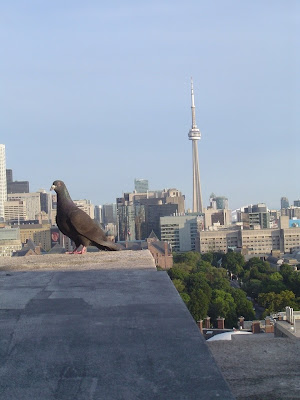 You’d expect opera to be “big” but… in some cases, you’d be wrong.
You’d expect opera to be “big” but… in some cases, you’d be wrong.
As I detailed in my last blog post, the grandeur normally associated with the opera Aida has been unceremoniously stripped away in the most recent production from the Canadian Opera Company. This would be noble, but for the fact that the concept itself trumps the heart of the piece, rendering it a hollow, pretentious shell, and giving it the sort of empty grandeur director Tim Albery was purposely going against. That doesn’t mean I didn’t have a super-thrilling, emotional experience involving grandeur the very-same night, though. Quite the opposite.
“Big” as a concept (specifically applied to a live musical event) was openly celebrated once outside the Four Seasons Centre the night of Aida’s opening. My opera-mate and I walked into the start of Nuit Blanche, the fifth annual all-night celebration of all things artistic. Now, I railed against the event in this blog last year, but having spoken with several people who both work inside of it and/or adore it, well… my position has somewhat softened. I have to admit, it does offer a cool experience, though I wish it was more than once a year (say, in the summer, during or just before Luminato) and not just a single all-night, foot-wrecking event. This year I was eager to see Daniel Lanois‘ brilliant, beautiful Later That Night At The Drive-In, held at Toronto’s Nathan Phillips Square, directly in front of City Hall. The space is normally a huge, empty expanse of concrete, with a functioning ink rink in the winter, but during this year’s Nuit Blanche, it was utterly transformed into… well, a drive-in. Kind of. Together with local artists and a team of talented organizers, Lanois had transformed the space into a truly communal setting where the idea of “spectacle” (whether it be drive-in, rock concert, whatever) was being mocked, milked, celebrated, and shared.
As if in direct opposition to Albery and his pretentiously over-wrought ‘concept’, here, the sense of civic grandeur was played into and played with; to quote Madonna, “Music makes the people come together“, or, of course, the man himself, “I’m not a stranger in the eyes of the maker” -and the maker was us, him, the night, the light, the shadows, the speakers, the sets of eyes and ears and hearts, beating together and out-of-time, in-time, with music, beats, and angles. The maker was the place itself and the people filling it. Visually, ‘Drive-In’ was intoxicating: a series of geometric screens were set up all over the square, on scrims and tall screens, offering live feeds of action happening further inside -but this wasn’t a glorified concert experience. The visuals portrayed dancers, prancers, techies, hanger-ons, and onlookers. If there’s one word to describe the experience, it’d be “immersive” -one was literally immersed in sound, light, colour, and the experience of togetherness within the grandeur of a large outdoor music thingamadoodle. Really. I got the keen sense Lanois et al were purposely keeping away from easy definitions in their presentation, that they were going after something already extant within Lanois’ music: the magical, the meditative, the intimate and the epic, all at once.
 So it was no accident the music emanating from Later That Night At The Drive-In was audible three city blocks away. That’s not to say it was L-O-U-D in the rock concert way; rather, there was a feeling of intimacy and sharing amidst the Nuit Blanche crowds, and surrounding this most grand of events, in one of the city’s biggest outdoor public spaces. Instead of shunning the idea of “big”, Lanois and his team were openly embracing it, using the intimacy and immediacy of live music to draw people together. A huge mirror was mounted above the small, Arabesque stage on an extreme angle, so that the small square became a kind of hallowed, silvery frame, bathing everything -and everyone -both in and outside of it in a holy, haunting light that whispered, “you are here, I am here, we are all together… “
So it was no accident the music emanating from Later That Night At The Drive-In was audible three city blocks away. That’s not to say it was L-O-U-D in the rock concert way; rather, there was a feeling of intimacy and sharing amidst the Nuit Blanche crowds, and surrounding this most grand of events, in one of the city’s biggest outdoor public spaces. Instead of shunning the idea of “big”, Lanois and his team were openly embracing it, using the intimacy and immediacy of live music to draw people together. A huge mirror was mounted above the small, Arabesque stage on an extreme angle, so that the small square became a kind of hallowed, silvery frame, bathing everything -and everyone -both in and outside of it in a holy, haunting light that whispered, “you are here, I am here, we are all together… “
Whatever expectations onlookers may have brought were both exceeded and gently, deftly, pushed to one side. Big isn’t always bad; there just has to be a big heart behind it, one to make all the others feel they’re somehow a part of it -singing, playing, dancing, moving and being moved. At the end of the day, Big Idea has to equal Big Heart, and sometimes, with the right amount of care, it also equals Big Art. Bravo Monsieur Lanois.


